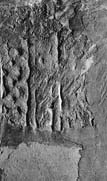Select a site alphabetically from the choices shown in the box below. Alternatively, browse sculptural examples using the Forward/Back buttons.
Chapters for this volume, along with copies of original in-text images, are available here.
Object type: Two fragments, perhaps from a single grave-cover
Measurements:
a: L. 32 cm (12.6 in) W. 33 cm (13 in) D. Built in
b: L. c.35 cm (13.8 in) W. c. 15 cm (5.9 in) D. Built in
Stone type: [Ancaster Freestone, Upper Lincolnshire Limestone, Inferior Oolite Group]
Plate numbers in printed volume: Ills. 365–6
Corpus volume reference: Vol 5 p. 261
(There may be more views or larger images available for this item. Click on the thumbnail image to view.)
Stone 3a. A section from a probable grave-cover decorated with interlace in low relief. The visible decorated face has been recut for reuse such that the surface has been progressively planed away so that no decoration at all survives towards one edge of the stone. The decoration is divided into three zones by two undecorated fillets of rectangular section. The two outside panels are filled with runs of a simple and rather inaccurate three-strand plait. To one side this survives in good condition but to the other only its outline against the central fillet is now visible. The narrow central panel, in between the two fillets, is occupied by a two-strand plait or twist, in which one strand only is articulated with an incised medial line.
Stone 3b. A fragment decorated with interlace in low relief. The panel retains a narrow undecorated border of rectangular section within which is a run of rather inaccurate three-strand plait. The three-strand plait is of similar size and appearance to the lateral zones on 3a and, consequently, this probably represents another fragment from the same original monument.
Stone 3a is probably a section from the central part of a large grave-cover divided longitudinally by a central shaft. This shaft may well have had a cross-bar. If part of a cross then this cover would bear comparison, for example, with the Ewerby cover (Ill. 170), where a centrally placed cross-shaft of similar dimensions is also outlined by two fillets. The central zone of the Ewerby cross, however, is undecorated. But the tradition of filling-in the shafts of large crosses on grave-cover lids is widespread, and is associated particularly with a group of covers including examples at Peterborough Cathedral, Cambridge Castle etc. and represented in Lincolnshire by the monument at Tallington (Ill. 360). The same feature is occasionally seen in the north of the county, however, where the cross elaborated with chevron ornament or cable moulding on a grave-marker at Glentworth might be seen as a variation on this theme (Ill. 179). All of these parallels are dated to the late tenth or eleventh centuries and such a date must be indicated for Syston 3 also.



